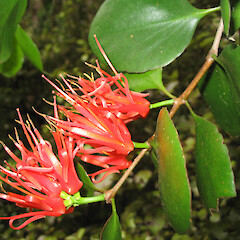Peraxilla colensoi
Common name
Scarlet mistletoe, korukoru, pirita, roeroe
Synonyms
Elytranthe colensoi (Hook.f.) Engl. Loranthus colensoi Hook. f.
Family
Loranthaceae
Flora category
Vascular – Native
Endemic taxon
Yes
Endemic genus
Yes
Endemic family
No
Structural class
Trees & Shrubs - Dicotyledons
NVS code
The National Vegetation Survey (NVS) Databank is a physical archive and electronic databank containing records of over 94,000 vegetation survey plots - including data from over 19,000 permanent plots. NVS maintains a standard set of species code abbreviations that correspond to standard scientific plant names from the Ngä Tipu o Aotearoa - New Zealand Plants database.
PERCOL
Chromosome number
2n= 24
Current conservation status
The conservation status of all known New Zealand vascular plant taxa at the rank of species and below were reassessed in 2017 using the New Zealand Threat Classification System (NZTCS) – more information about this can be found on the NZTCS website. This report includes a statistical summary and brief notes on changes since 2012 and replaces all previous NZTCS lists for vascular plants.
Please note, threat classifications are often suggested by authors when publications fall between NZTCS assessment periods – an interim threat classification status has not been assessed by the NZTCS panel.
- Conservation status of New Zealand indigenous vascular plants, 2017 . 2018. Peter J. de Lange, Jeremy R. Rolfe, John W. Barkla, Shannel P. Courtney, Paul D. Champion, Leon R. Perrie, Sarah M. Beadel, Kerry A. Ford, Ilse Breitwieser, Ines Schönberger, Rowan Hindmarsh-Walls, Peter B. Heenan and Kate Ladley. Department of Conservation. Source: NZTCS and licensed by DOC for reuse under the Creative Commons Attribution 4.0 International licence.
2017 | At Risk – Declining | Qualifiers: CD
Previous conservation statuses
2012 | At Risk – Declining | Qualifiers: CD
2009 | At Risk – Declining | Qualifiers: CD
2004 | Gradual Decline
Brief description
Fleshy shrub to 3m wide growing on outer branches of beech trees with glossy green fleshy paired leaves and masses of red tubular flowers. Leaves to 8cm long, smooth with a red edge. Flowers to 2.5cm long. Fallen petals litter forest floor under plants. Fruit yellow.
Distribution
North and South Island, but common only in southern parts of the South Island.
Habitat
A parasite mainly found in silver beech forest but has been recorded on 16 host species (9 exotic) in New Zealand including red beech and black beech. Tui (Prosthemadera novaeseelandiae) and bellbird (Anthonis melanura) disperse this species in the North Island.
Detailed description
A shrub up to 3 m across. It parasitises further out on branches of its host than Peraxilla tetrapetala. The veins on leaves are hardly evident and only the midrib is conspicuous. Leaf tips are never notched and the leaves themselves are large and never blistered. The leaves sit in pairs on opposite sides of the stem and are thick and have a leathery texture. Leaf margins are usually smooth with red slightly rough margins. Masses of scarlet flowers make this plant very obvious from October - January. Flower heads have groups of 3-10 flowers and are up to 60 mm long. The ripe fruit are yellow/golden and are small, fleshy and oval.
Similar taxa
Peraxilla tetrapetala, Ileostylus micranthus. Peraxilla colensoi is a larger plant with larger leaves than P. tetrapetala, has flowers in clumps of 3-10 and grows on silver beech. P. tetrapetala has leaves with blister galls, flowers in clumps of 1-3 and grows on black or mountain beech. Ileostylus micranthus does not grow on beech trees and has small, greenish flowers.
Flowering
October to January
Flower colours
Red/Pink
Propagation technique
Can be grown from fresh seed placed on suitable host tissue (ideally Nothofagus menziesii). Although seed germinates readily the ability of the seedling to form a firm host is rather variable. Failure rates are high and experimentation with plenty of fresh seed is usually needed.
Threats
A wide variety of threats are now acknowledged as working in unison to cause the national decline of this and allied leafy mistletoes species. The most obvious threat seems to be brush tailed possums (Trichosurus vulpecula), which heavily browse mistletoes, to such an extent that they are held as the primary cause for the loss of the beech mistletoes from large parts of the countries beech forest.
Etymology
colensoi: Named after William Colenso (7 November 1811 - 10 February 1899) who was a Cornish Christian missionary to New Zealand, and also a printer, botanist, explorer and politician.
Where To Buy
Not commericially available
Other links
Image of the haustoria of Peraxilla colensoi by John Dawson (from Forest Vines to Snow Tussocks).
Attribution
Fact sheet prepared by P.J. de Lange for NZPCN (1 June 2013)
References and further reading
NZPCN Fact Sheet citation
Please cite as: de Lange, P.J. (Year at time of access): Peraxilla colensoi Fact Sheet (content continuously updated). New Zealand Plant Conservation Network. https://www.nzpcn.org.nz/flora/species/peraxilla-colensoi/ (Date website was queried)



















